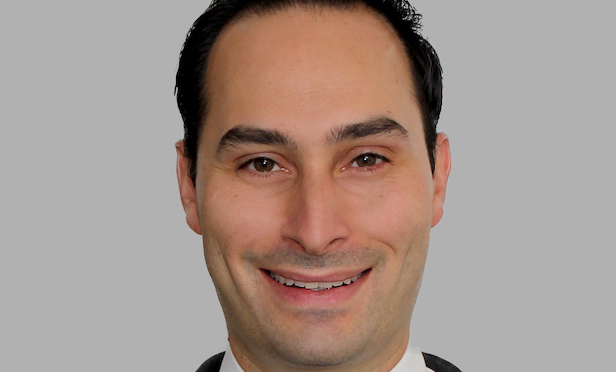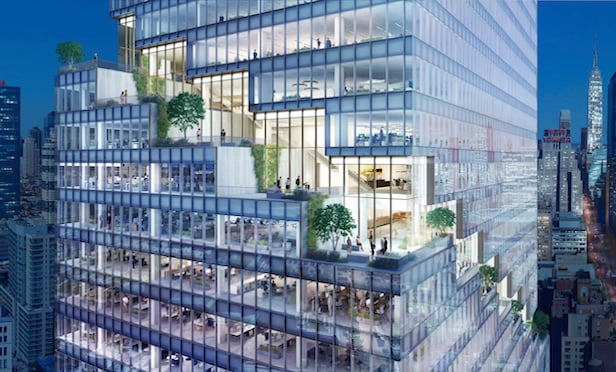 Joshua King, executive managing director, Cushman & Wakefield's capital markets team
Joshua King, executive managing director, Cushman & Wakefield's capital markets team
NEW YORK CITY—Some real estate deals are noteworthy not due to just dollars or players involved but because they serve as an industry weathervane. For example, Cushman & Wakefield was tapped to sell Pfizer's world headquarters on E. 42nd Street. In a sale leaseback deal, the joint venture of Alexandria Real Estate Equities, David Werner Real Estate, Deutsche Bank and the State of Wisconsin Investment Board purchased the property at 219 E. 42nd St. and 235 E. 42nd St. for $363.5 million. This allowed Pfizer to stay in its locations and time to negotiate into a choice building for its next move.
A Cushman team then assisted Pfizer in leasing 800,000 square feet in the Spiral, Tishman Speyer's eye-catching development that's underway. It's a 65-story, 2.8 million square-foot tower designed by Danish architect Bjarke Ingels. With terraces that swirl around the building and hanging gardens, it's already turning heads—and the building isn't even opening until 2022.
 The Spiral's cascading terraces/ Image courtesy of Tishman Speyer
The Spiral's cascading terraces/ Image courtesy of Tishman SpeyerBut it's not just the global client names, architectural flourishes and creative financing. The high stakes also lie in knowing where the market's at and where it's headed in the future. Josh King, Cushman & Wakefield's executive managing director, capital markets, shares his team's insider insights and strategies in the life sciences sector.
Q: It seems as though healthcare real estate has moved from being a more niche investment strategy to something more mainstream. Given how active your team is what have you been hearing from investors?
Joshua King: Most institutional investors believe demand for healthcare will continue to increase given the demographic tailwinds in the US and in many advanced societies across the world where declining birth rates and medical advances are resulting in longer life expectancies and an aging population.
There are many property types that should benefit from these dynamics. The three most commonly cited are medical office, senior housing and life sciences. There's a pretty wide spectrum of investors interested in healthcare properties. Most notably there are the healthcare REITs like Welltower, HCP, Ventas and Alexandria who dominate the sector, some of whom invest in all these property types and others of whom specialize in just one.
But beyond the REITs virtually all institutional investors have demand for it that typically exceeds the supply of available opportunities. While the healthcare industry represents the third largest sector of the S&P 500 (~15%), it is a niche sub-sector of real estate with limited inventory particularly in high-barrier-to-entry markets like New York City.
Q: Speaking of New York City—an increased focus on life sciences seems to be a trend lately, what are you seeing?
King: When you look at the Manhattan office market since the financial crisis, the big story has been about how the New York City economy has become more diversified. Twenty years ago if you were graduating college and wanted a high-paying job and to live in Manhattan, you pretty much were headed to Wall Street. But since the financial crisis, the job market in New York City has become largely driven by technology, media and other emerging industries.
The path of technological progress in the past 20 years has been unprecedented. The iPhone only came into existence in 2007 and the modern internet only in the late 1990s. Yet these technologies have transformed the world irrevocably in an extremely short time span.
The next 20 years will yield similar advancements, not just in tech, but also in biotech and life sciences. What makes the intersection of real estate and life sciences so enticing is we are literally providing space for the companies seeking to commercialize these breakthroughs in cures and technologies that will prolong and enhance the quality of our lives.
Q: What sets life sciences real estate apart from regular office buildings?
King: Typically when you hear someone talk about life sciences real estate they are talking about laboratory space or “wet labs” as it's often referred to. This is space where scientists are conducting biological research and the requirements to facilitate this use (infrastructure, HVAC technology, zoning requirements) are highly nuanced.
Alexandria was the pioneer in this space and was the first real estate company to develop for-profit purpose-built laboratory space in New York City with the development of Alexandria Center for Life Sciences on the East Side. What has become more of a trend lately is the extent to which life sciences companies are engaged in computational research or “Big Data” which is less reliant on expensive lab build outs.
This type of research bears a closer resemblance to jobs at Google or Facebook than jobs at a big pharma company working in the laboratory. The space requirements tend to be more open layouts with exposed ceilings and benched seating like you would see in typical creative office space.
 Pfizer world headquarters on E. 42nd St.
Pfizer world headquarters on E. 42nd St.Q: You mentioned Alexandria earlier, your team worked on the sale of the Pfizer Headquarters last year to David Werner and Alexandria which was an interesting partnership. What was the logic behind it?
King: The Pfizer transaction made a lot of strategic sense given that Pfizer is one of the largest life science companies in the world. While Pfizer will be relocating to the Spiral on the far West Side, they negotiated a short-term leaseback and remain the major occupant of the complex for the next several years.
The asset is also located on the eastern edge of Midtown along 2nd Avenue which makes it proximate to a lot of the medical research institutions and hospitals located along the East River which is typically a major driver for life science companies. The building also offers physical characteristics that could work well for life sciences including high ceilings as well as available air rights for further development. So the site offers a lot of what life sciences tenants are looking for.
Q: Long Island City has been in the headlines, most notably for the rise and fall of Amazon HQ 2.0. Why do you think LIC makes sense for Life Sciences?
King: There was actually a good story beginning to emerge in LIC in the months leading up to the Amazon announcement which was ultimately overshadowed by the Amazon saga. A month or so before the announcement our team completed an off-market transaction selling the Bindery, a former converted warehouse building in the Factory District, to Alexandria on behalf of Brickman / Third Point.
 Doug Harmon and Adam Spies, co-chairs, capital markets, Cushman & Wakefield/ Their team represented Pfizer in the sale leaseback of its headquarters and sale of the Bindery in LIC to Alexandria.
Doug Harmon and Adam Spies, co-chairs, capital markets, Cushman & Wakefield/ Their team represented Pfizer in the sale leaseback of its headquarters and sale of the Bindery in LIC to Alexandria.Since then there have been some other announced life science projects in the sub-market such as GFP/King Street's deal in Court Square. We think LIC represents an appealing combination of factors for the industry including a large stock of factory/warehouse buildings that can convert well to life sciences given their high ceilings, heavy floor load capacities and abundant roof space for mechanical equipment.
Additionally much of LIC is located within an M-zone which offers the most flexible zoning for lab space. Also, LIC provides very easy access to the medical/hospital/research institutes along the East River in Manhattan as well as to Cornell/Technion's campus on Roosevelt Island.
Our hope is that a life sciences cluster begins to form in LIC and that it can gradually grow into a miniature Cambridge or Palo Alto. Had the Amazon deal gone through it certainly would have helped to catalyze that. It should be noted that shortly after they pulled the plug on HQ2, within weeks Savanna announced the back-fill of half a million square feet at One Court Square with Centene, a large St. Louis based healthcare company.
Q: What's your prediction for the future of the industry and its impact on real estate in New York City?
King: While the future is bright for the industry, it will take time for it to mature. Cambridge got an early start. Without significant public-private investment, it wouldn't be where it is today. Venture capital is very closely intertwined with the industry and is a major driver. The amount of VC funding taking place in Bay Area and Cambridge still significantly trumps what's occurring for the sector in New York City.
Still, what we can offer here is incredible talent given the large number of high-caliber medical facilities located in New York. Also, life sciences merges with tech more broadly. New York City's vast talent pool will become of increasing attraction to life science firms looking to establish a presence.
One other thing we are seeing is more life science real estate players emerging in the incubator space which is sort of a hybrid of co-working and life sciences for smaller startup type groups who can't commit to a long-term lease.
Q: What interests you personally about the Life Sciences space?
King: I've always had an interest in science and technology. I was originally going the pre-med route in college before switching to real estate and finance. My dad was a doctor and my brother followed that path. He is now a research scientist at Stanford with an MD/PhD specializing in cutting-edge research that combines genetics and computer science. While real estate isn't an altruistic calling, working on life sciences deals is especially satisfying in that we are facilitating the mission of companies that will advance medicine and improve human lives around the world.
© 2025 ALM Global, LLC, All Rights Reserved. Request academic re-use from www.copyright.com. All other uses, submit a request to [email protected]. For more information visit Asset & Logo Licensing.








